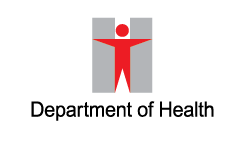Coronavirus Disease 2019 (COVID-19)
Click here to view the thematic website of "COVID-19"
Click here to view the thematic web page of "COVID-19 Vaccination Programme"
Causative agent
Coronavirus disease 2019 (COVID-19) is an infectious disease caused by the SARS-CoV-2 virus.
Clinical features
The most common symptoms of COVID-19 include fever, chills and sore throat. Other symptoms include severe fatigue, loss or change of sense of taste and /or smell, nasal congestion, conjunctivitis, headache, muscle or joint pain, skin rash, nausea or vomiting, diarrhea and dizziness. Some people may only have very mild or non-specific symptoms, while some may develop severe symptoms like shortness of breath, chest pain or confusion.
Complications may include respiratory failure, acute respiratory distress syndrome (ARDS), sepsis and septic shock, thromboembolism, and/or multi-organ failure including injury of the heart, liver or kidneys. There are reports that children and adolescents with COVID-19 may develop a rare but serious condition known as multisystem inflammatory syndrome in children (MIS-C), leading to multiorgan failure and shock.
People over age 60 and those with existing medical conditions including hypertension, heart and lung problems, diabetes, obesity, cancer and pregnancy are at higher risk of developing serious illness.
Post COVID-19 condition, commonly known as long COVID, can affect anyone exposed to SARS-CoV-2, regardless of age or severity of original symptoms.
The World Health Organization (WHO) defines long COVID as the continuation or development of new symptoms 3 months after the initial SARS-CoV-2 infection, with these symptoms lasting for at least 2 months with no other explanation.
Common symptoms of long COVID include fatigue, shortness of breath, cognitive dysfunction, headache, chest pain, joint pain and may have an impact on everyday functioning. Studies showed that approximately 10-20% of people infected with COVID-19 may go on to develop symptoms that can be diagnosed as long COVID. WHO recommends that protection from long COVID means protecting yourself and others from COVID-19 infection in the first place. Some simple and proven measures can help to this including:
- Taking up offers of COVID-19 vaccines/boosters
- Wearing well-fitted masks
- cleaning hands regularly
- ensuring indoor spaces are well ventilated
For more information on long COVID, please refer to the long COVID page under the thematic website of COVID-19.
Mode of transmission
Mode of transmission includes through respiratory droplets, contact of contaminated surfaces or objects, short-range aerosol or short-range airborne transmission. The virus can also spread in poorly ventilated and/or crowded indoor settings.
Incubation period
Incubation periods may differ by SARS-CoV-2 variant. Most estimates of the incubation period range from 1 to 14 days, and some variants, such as the Omicron variant, may have even shorter incubation period of around 3 days.
Management
Treatment includes supportive therapy, symptomatic treatment, antiviral agents and Chinese medicine.
Prevention
COVID-19 vaccination
- Members of the public are advised to take note of the latest recommendations on the use of COVID-19 vaccines in Hong Kong to protect themselves from serious outcomes of COVID-19.
- For details on COVID-19 vaccination, please refer to thematic web page for COVID-19 Vaccination Programme: https://www.chp.gov.hk/en/features/106934.html
Health advice
Members of the public are also advised to maintain strict personal and environmental hygiene at all times for personal protection against infection and prevention of the spread of the disease in the community:
- The wearing of mask is advised for the following situations -
- any persons with fever or respiratory symptoms;
- any persons who are visiting or working in high risk places such as residential care homes for the elderly, residential care homes for persons with disabilities, and clinical areas of healthcare facilities; and
- high risk persons (e.g. persons with underlying medical conditions or persons who are immunocompromised) who are going to crowded places such as public transport.
- when an increasing trend in activity of respiratory viruses including SARS-CoV-2 virus is expected, high risk persons are recommended to wear a surgical mask when visiting public places, while the public should also wear a surgical mask when taking public transportations or staying at crowded places.
- It is important to wear a mask properly, including perform hand hygiene before wearing and after removing a surgical mask. For details on proper mask wearing, please visit CHP website at www.chp.gov.hk/files/pdf/use_mask_properly.pdf;
- Avoid touching your eyes, mouth and nose before washing hands;
- Perform hand hygiene frequently, especially before touching one's mouth, nose or eyes; before eating; after using the toilet; after touching public installations such as handrails or door knobs; or when hands are contaminated by respiratory secretions after coughing or sneezing;
- Cover your mouth and nose with tissue paper when sneezing or coughing. Dispose of soiled tissues into a lidded rubbish bin, then wash hands thoroughly;
- Wash hands with liquid soap and water, and rub for at least 20 seconds. Then rinse with water and dry with a disposable paper towel. When the hands are cleaned, do not touch the water tap directly again (for example, using a paper towel to wrap the faucet before turn it off). If hand washing facilities are not available, or when hands are not visibly soiled, performing hand hygiene with 70 to 80% alcohol-based handrub is also an effective alternative;
- After using the toilet, put the toilet lid down before flushing to avoid spreading germs;
- Maintain good indoor ventilation;
- Home should be cleaned thoroughly at least once per week with 1 in 99 diluted household bleach (mixing 10 ml of bleach containing 5.25% sodium hypochlorite with 990 ml of water), leave for 15 - 30 minutes and then rinse with water. For metallic surface, disinfect with 70% alcohol. For more information on the use of bleach, please visit the following webpage: https://www.chp.gov.hk/files/pdf/the_use_of_bleach.pdf;
- If places are contaminated by respiratory secretions, vomitus or excreta, use strong absorbent disposable towels to clean up the visible matter. Then disinfect the surface and the neighbouring area with appropriate disinfectant. For nonmetallic surface, disinfect with 1 in 49 diluted household bleach (mixture of 10ml of household bleach containing 5.25% sodium hypochlorite solution with 490ml of water), leave for 15 to 30 minutes, and then rinse with water. For metallic surface, disinfect with 70% alcohol;
- Maintain drainage pipes properly and regularly (about once a week) pour about half a litre of water into each drain outlet (U-traps) to ensure environmental hygiene;
- Build up good body resistance and maintain healthy lifestyle. This can be achieved through balanced diet, regular exercise and adequate rest and
- Do not smoke and avoid alcohol consumption.
Health advice for persons tested positive for COVID-19
Persons tested positive for COVID-19 should take heed of the health advice below:
- Persons who are at higher risk (e.g. immunosuppressed people, older people, people with underlying medical conditions) and persons who developed obvious symptoms are advised to seek prompt medical advice;
- Persons who are symptomatic are advised to stay at home and avoid going out. Persons who are asymptomatic can go out at their own will or go to work.
- Students who are symptomatic should not attend schools;
- Infected persons are advised to wear well-fitting surgical masks, KF94 masks, KN95 masks or respirators (such as N95 respirators) during the first five days after testing positive. They should also avoid contact with persons who are at higher risk, contact with others in mask-off situation (e.g. share table with others for meal), going to crowded places and mass gatherings;
- Closely monitor health condition and seek medical advice promptly if symptoms arise or getting worse;
- Keep your home well ventilated by having windows opened as far as feasible; and
- Pay attention to personal and environmental hygiene at all times. Clean and disinfect the shared items and facilities (e.g. toilet) at home frequently and after use.
Other languages
| Bahasa Indonesia Version Bahasa Indonesia |
Tagalog Version Tagalog |
Thai Version ไทย |
| Hindi Version हिन्दी |
Nepali Version नेपाली |
Urdu Version اردو |
| Sinhala Version සිංහල භාෂාව |
Bengali Version বাংলা ভাষা |
Vietnamese Version Tiếng Việt |
- Other Related Guidelines
- Centers for Disease Control and Prevention, USA
- Chinese Center for Disease Control and Prevention
- Family Health Service, Department of Health
- Student Health Service, Department of Health
- Travel Health Service, Department of Health
- World Health Organization
- Outbound Travel Alert - Security Bureau
















